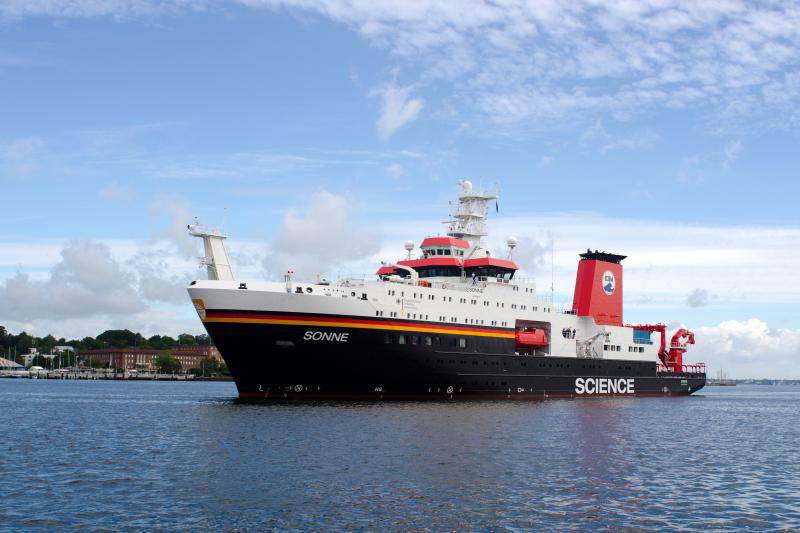SONNE SO307
- Area:
- Western Indian Ocean
- Time:
-
12.09.2024 - 28.10.2024
- Institution:
- GEOMAR
- Chief scientist:
- Jörg Geldmacher
Expedition SO307 onboard Germany’s research vessel SONNE will carry out scientific work for the main geological project (MADAGASCAR), a sub-project from the biological oceanography (INDICOM) (both led and carried out by GEOMAR), as well as a biological sub-project (MADAGASCAR-BIO) of the Museum für Naturkunde Berlin.
Main Project MADAGASCAR (Working Group Petrology and Geochemistry of the Seafloor, Prof. Dr Kaj Hoernle, GEOMAR):
Oceanic plateaus are large-scale underwater mountain ranges, often several kilometers high, with relatively flat summit areas ("plateau"). Although most of these plateaus are probably of volcanic origin, there are other theories proposed, in especially for the southwestern Indian Ocean. Between Madagascar and Antarctica there are several prominent bathymetric highs, including the Madagascar Ridge and the section of the mid-ocean ridge immediately to the south, together forming the Marion Rise.
It is generally assumed that oceanic plateaus are formed by material rising in the Earth's mantle, so-called mantle plumes, which arrive at the base of the oceanic plate in the vicinity of mid-ocean ridges. The hot, less dense and easily melted plume material then flows along the base of the plate to the spreading center of the mid-ocean ridge, resulting in an uplift of the ocean floor and, through increased volcanism, to a thickening of the oceanic crust formed there.
This model has recently been challenged by proposing that the Marion Rise and possibly many other elevated plateaus in the world's oceans are due to a different composition of the upper mantle (original publication by Zhou and Dick published in Nature 494 in 2013). This idea is based on the abundant occurrence of peridotite (instead of volcanic basalt) at the mid-ocean ridge section on the Marion Rise. Peridotite is a common mantle rock but is thought to occur here in lower density, generating enough buoyancy to explain the uplift of the entire Marion Rise. To generate less dense mantle material beneath the Marion Rise, previous melting events are required. These events could have led to the formation of several continental volcanic areas in the region (e.g. Karoo in South Africa, Ferrar in Antarctica and also widespread volcanism in Madagascar), related to the break-up of the southern continent Gondwana and the separation of India from Madagascar between 180 and 90 Ma.
If this hypothesis is correct, the Madagascar Ridge would also not be a magmatic formation, i.e. consisting of volcanic basalt, but uplifted mantle material of modified peridotite, which extends along the spreading direction from the mid-ocean ridge to the Madagascar shelf.
Alternatively, the Madagascar Ridge, or at least parts of it, could also consist of thinned continental crust, similar to the submarine parts of the New Zealand microcontinent Zealandia.
Planned rock sampling will help distinguish between these theories and clarify the formation processes of oceanic plateaus.
Subproject INDICOM (Research Unit Biological Oceanography, Prof. Dr Anja Engel, GEOMAR):
This biological oceanography project investigates the turnover of dissolved and particulate organic material in the entire water column down to the sea floor. Water samples from different depths are collected by Rosette/CTD. The focus is on the investigation of potentially labile and semi-labile organic compounds in the deep Indian Ocean, which potentially drive the microbial turnover of organic carbon in the deep sea. For this purpose, processes of heterotrophic bacteria are studied in close connection with a detailed chemical analysis of the organic material. A particular focus is on the investigation of gel particles that bridge the gap between the dissolved and particulate phases. Carbohydrate- and protein-rich gels have been detected in shallower and intermediate depths of the ocean, but their role in the turnover of organic matter in the deep sea is unknown. Investigating mechanisms that regulate bacterial processing of organic matter will help to better understand and quantify carbon fluxes in the deep ocean. The results will thus help to improve climate models and assess possible future climate fluctuations.
Subproject MADAGASCAR-BIO (Working Group Prof. Dr Carsten Lüter, Museum für Naturkunde Berlin):
The biological investigations in the deep sea at the Madagascar and South-West Indian Ridge aim to describe the diversity of certain animal groups living in the sediment of the sea floor and to identify cryptic species using genetic methods. It will also test the hypothesis that oceanic highs, such as the Madagascar Ridge, and their parallel-running water currents facilitate the dispersal of species. Furthermore, it will be examined whether the presence of nutrients is a factor in the diversity of the animal groups found. The focus will be on sampling hard-bottom fauna, but sediment dwellers at the base of geomorphological structures will also be included. The recording and determination of species diversity in the study area will serve the long-term monitoring of deep-sea biodiversity and will provide information on the dispersal ability of certain sessile and holobenthic invertebrates in the deep sea.



